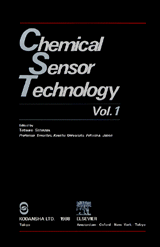Chemical Sensor Technology, Vol. 1

内容紹介
<英文書>
ガスセンサ、バイオセンサ、イオンセンサなど化学センサの基礎、実用化、応用に関する最新の先導的研究を集録。国際的に精選された第一線の研究者が、新技術の展開のみならず研究思想や方法論にも言及。信頼性の高い情報を提供する最新のシリーズ第1巻。海外提携先:Elsevier B.V.
目次
Chemical Sensors -- Current State and Future Outlook
1. Introduction
2. Current State of Chemical Sensors and Advances Expected in the Near Future
3. Application of Chemical Sensors
4. Chemical Sensors in the Distant Future
5. Conclusion
Physical and Chemical Aspects of Oxidic Semiconductor Gas Sensors
1. Introduction
2. Models for Metal Oxide Surfaces
3. Surface Reactions
4. Modified Surfaces
5. Conclusion
Tin Dioxide Sensors-Development and applications
1. Introduction
2. Highly Sensitive SnO2 Gas Sensor for Volatile Sulfides
3. Development of a Superior Long-term Sensor
4. New Applications
5. Conclusion
Development and Application of Ceramic Humidity Sensors
1. Introduction
2. Sensors and Ceramics
3. Adsorption and Ceramics
4. Ceramic Humidity Sensors
Limiting Current Type Oxygen Sensors
1. Introduction
2. Principle and Pinhole Type of Limiting Current Oxygen Sensor
3. Porous Coating Type Sensor
4. Thin Film Type Sensor
5. Some Remarks on Sensor Designing
6. Sensor Characteristic for Various Gas Mixtures
7. Examples of Application
8. Concluding Remarks
Solid-Electrolyte Sensors for SO2 and/or SO3
1. Introduction
2. Guidelines for Developing Solid-Electrolyte Sensors for SO2 and/or SO3
3. Single-Phase Sulfate-Electrolyte Sensors
4. Thin-Film Sulfate-Electrolyte Sensors
5. Two-Phase Sulfate-Electrolyte Sensors
Use of Zirconia Sensors in the Metallurgical Industry in Japan
1. Introduction
2. Use of Zirconia Sensors in Steelmaking
3. Use of Zirconia Sensors for Copper Refining
4. Concluding Remarks
Development of a Solid-State Gas Sensor Using Proton Conductor Operative at Room Temperature
1. Introduction
2. Potentiometric Sensor
3. Amperometric Sensor
4. Four-Probe Type Sensor
Ion Sensors for Microsampling
1. Microsampling in Potentiometry
2. Voltammetric Ion Sensors for Microsamplings
3. Transfer of Analytes from a Compartment of Larger Volume into a Smaller One for Amplified Electrochemical Detection
Suspended Gate Field Effect Transistor
1. Introduction
2. Theory of Suspended Gate Field Effect Transistor
3. Fabrication
4. SGFET Examples
5. Related Structures
6. Conclusions
Micromachining for Chemical Sensors
1. Introduction
2. Development of Fabrication Techniques for Microprobe Sensors
3. Application for Fabricating Chemical or Gas Analyzing Microsystems
4. Conclusions
Micro-Fabrication of Biosensors
1. Introduction
2. ISFET-based Sensors
3. Micro-Electrode-Based Sensors
4. Concluding Remarks
Medical Applications of the Glucose Sensor
1. Introduction
2. The Principle of Glucose Measurement by Intracorporeal Glucose Sensor
3. Preparation of a Needle-Type Glucose Sensor
4. In Vitro Characteristics of the Glucose Sensor
5. In Vivo Characteristics of the Glucose Sensor
6. In Vivo Monitoring
7. Problems Awaiting Solution in Long-Term Chemical Application of Glucose Sensor
8. Conclusion
Design and Applications of Biosensors in Medicine : Study on Artificial Pancreas
1. Introduction
2. Lactate Sensor
3. Pyruvate sensor
4. A System for Continuous Monitoring of Lactate and Pyruvate
5. 3-Hydroxybutyrate sensor
Optical Chemical Sensor
1. Introduction
2. Principles of the Optical Chemical Sensor
3. Functional Optical Sensor
4. Surface Effect Chemical Sensor
5. Summary